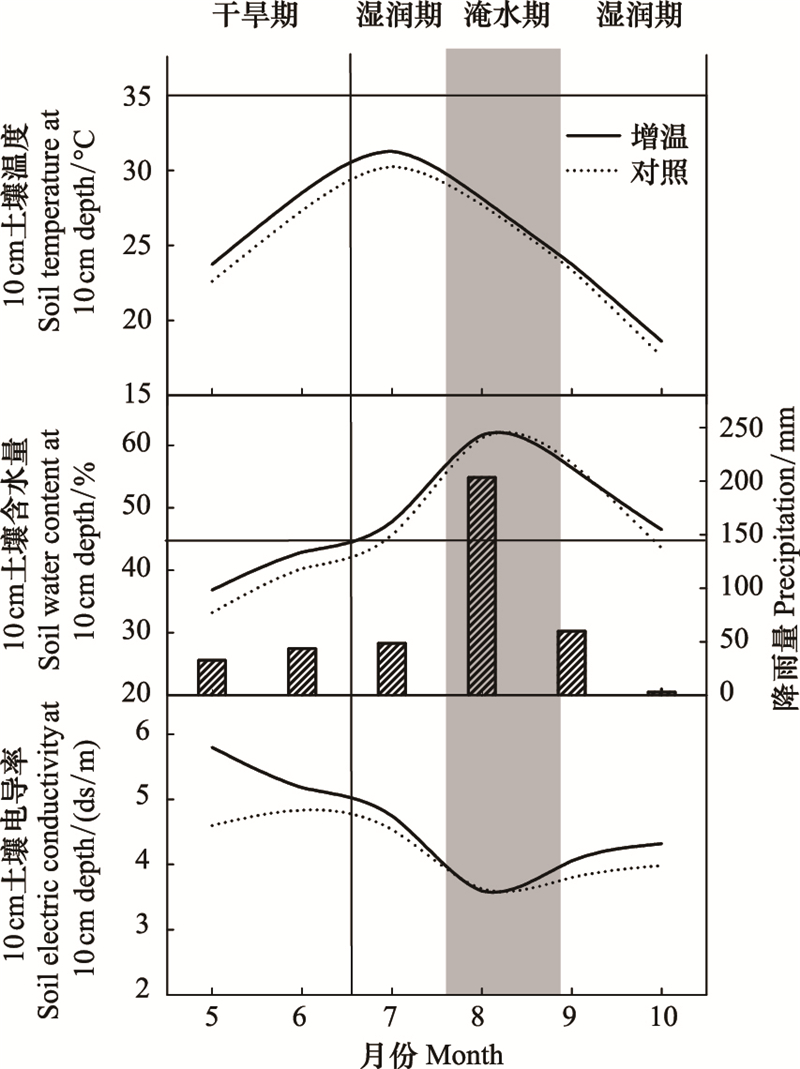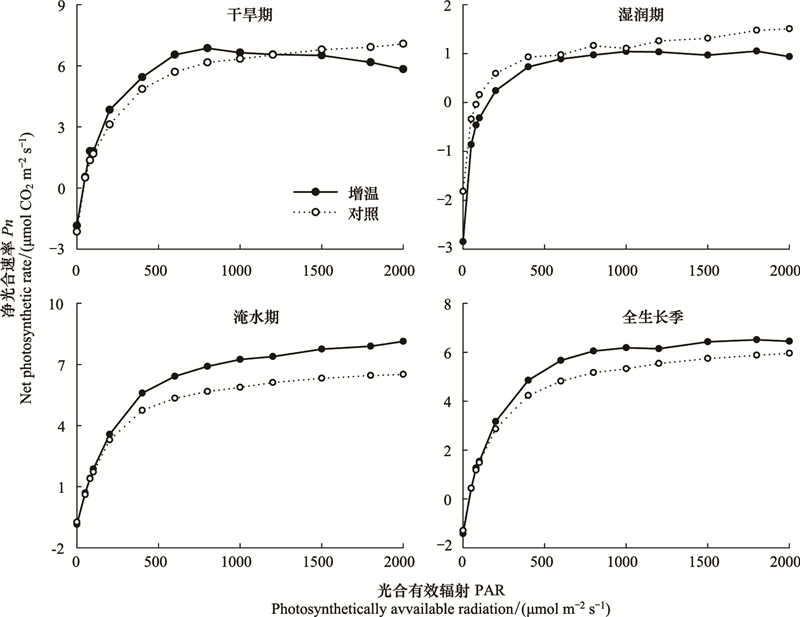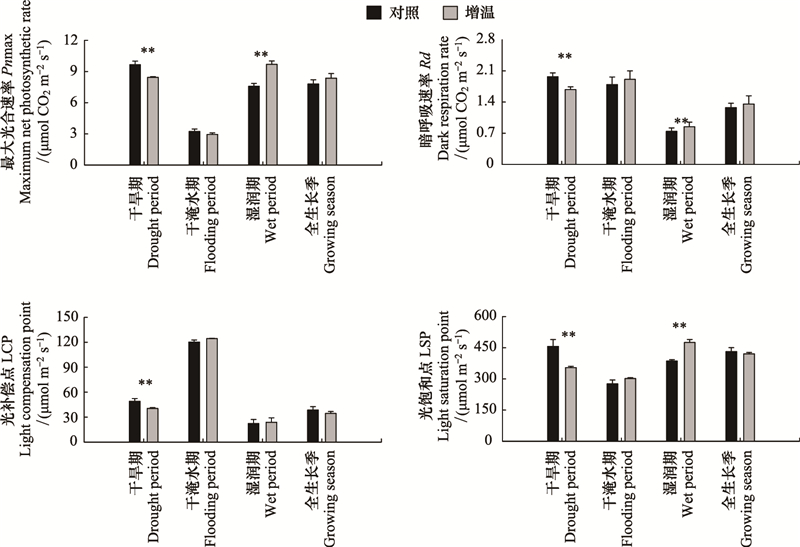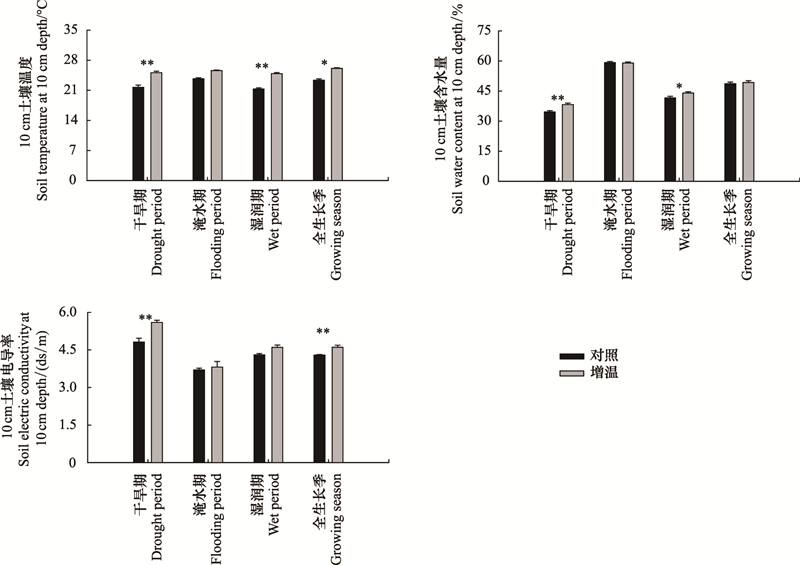文章信息
- 孙宝玉, 韩广轩, 陈亮, 王安东, 吴立新, 赵敏.
- SUN Baoyu, HAN Guangxuan, CHEN Liang, WANG Andong, WU Lixin, ZHAO Min.
- 短期模拟增温对黄河三角洲滨海湿地芦苇光响应特征的影响
- Effect of short-term experimental warming on photosynthetic characteristics of Phragmites australis in a coastal wetland in the Yellow River Delta, China
- 生态学报. 2018, 38(1): 167-176
- Acta Ecologica Sinica. 2018, 38(1): 167-176
- http://dx.doi.org/10.5846/stxb201611242401
-
文章历史
- 收稿日期: 2016-11-24
- 网络出版日期: 2017-09-12
2. 中国科学院大学, 北京 100049;
3. 聊城大学环境与规划学院, 聊城 252000;
4. 山东省黄河三角洲国家级自然保护区, 东营 257500;
5. 山东省东营市国土资源局, 东营 257091
2. University of Chinese Academy of Sciences, Beijing 100049, China;
3. College of Environment and Planning, Lioacheng University, Liaocheng 252000, China;
4. Administration Bureau of the Yellow River Delta National Nature Reserve, Dongying 257500, China;
5. Dongying Bureau of Land and Resources, Dongying 257091, China
光合作用是植物生长发育的基础, 同时也是研究植物适应环境胁迫的重要指标[1]。植物光响应曲线的测定及拟合是植物光合作用研究的重要手段之一[2], 由此获取的最大净光合速率、光补偿点、光饱和点及暗呼吸速率等光合参数[3-4], 是判定植株光合机构运转状况、光合作用能力、光合利用率以及受环境变化影响程度的依据[5]。研究表明, 温度是影响植物光合作用的主要环境决定因素[6]。其不仅对植物产生直接影响, 如对植物的生长周期、碳同化速率和暗呼吸产生直接效应[7];而且增温还可通过改变其他环境因子对植物产生间接影响, 主要包括改变土壤含水量和对营养物质的利用以及土壤盐分含量等[8]。不同物种对环境变化表现出不同的适应方式[9], 这势必对植物的生长及生理生态特性产生巨大影响[10]。大量研究表明, 温度对植物光合作用的影响不确定, 表现出增加[11-14]、下降[15-17]或无影响[18-19]。
黄河三角洲滨海湿地地处黄河入海口, 是我国三大河口三角洲之一, 也是中国暖温带地区最完整、最广阔、最年轻的新生湿地[20]。在全球气候变暖的背景下, 黄河三角洲地区在过去50年(1961—2010年)间平均气温上升1.85℃, 年平均温于1993年发生突变, 进入显著升温阶段[21]。一方面, 增温能直接影响湿地植物的光合和呼吸等过程, 改变植被的生长[22-24]。另一方面, 增温能加速蒸发, 使得土壤盐分在地表集聚[25-27], 在盐分胁迫下, 湿地植物的生长也将发生变化[28-30]。因此, 气温升高势必会影响湿地植物光合作用和光响应特征, 进而影响湿地植物生长和群落演替。近年来, 关于全球变暖下黄河三角洲滨海湿地的研究主要集中在碳循环、碳收支以及温室气体排放[31-32]等方面。而芦苇作为该类型湿地重要的优势物种, 其光合生理生态特性直接影响湿地生态系统的演变。但目前, 关于增温对芦苇影响的研究多局限于其生长、物候和繁殖方面[33-34], 对其光合特征以及对增温响应机制的研究较少, 但在崇明东滩的研究中, 认为一年增温能够提高芦苇的光合, 而升温2年由于光合适应而出现负效应[35-36]。但其并没有考虑增温引起的其他环境因子对芦苇光合的影响。因此, 本研究选取黄河三角洲滨海湿地为研究对象, 采用红外辐射加热器模拟增温, 对生长季(2015年5月初—2015年10月底)芦苇的光响应曲线以及环境因子等进行监测。分析增温对芦苇光响应特征的影响, 并探讨其响应机制, 为了解未来气候变暖对滨海湿地演变方向提供基础数据和理论依据。
1 材料与方法 1.1 试验地概况研究区位于山东省东营市的中国科学院黄河三角洲滨海湿地生态试验站(37°45′50″ N, 118°59′24″ E)。该地区属于温带半湿润大陆性季风气候, 阳光充足, 四季分明, 雨热同期。年平均气温为12.9℃, 最高气温41.9℃, 最低气温-23.3℃, 年降水量为550—640 mm, 70%降水集中于5—9月, 降水量的季节和年际变化较大, 年平均蒸发量为1962 mm [37]。该地区地势平坦, 植物生长茂盛, 土壤质地以轻壤土和中壤土为主, 土壤类型以潮土和盐碱土为主。研究区植被覆盖度为80%左右, 主要优势种为芦苇(Phragmites australis)、盐地碱蓬(Suaeda salsa)、碱菀(Tripolium vulgare)、鹅绒藤(Cynanchum chinense)等。试验区芦苇的盖度为30%左右。
1.2 实验设计试验采用随机区组设计, 设置增温和对照2个处理, 每个处理设置4个重复, 每个重复的小区面积为3 m×4 m, 区间距为3 m。样方面积2 m×3 m, 小区与样方之间预留0.5 m的缓冲区。采用MRM-2420型红外辐射器(Kalglo electronics Inc., Pennsylvania, USA)对试验小区进行模拟增温, 增温幅度为2℃。此装置的红外能量与太阳能量性质相同, 但是不包含紫外线。加热和不加热小区随机分布, 红外线辐射加热灯(长160 cm, 宽15 cm)额定功率为1000W/m2, 非生长季对4支加热灯进行24 h持续供电(220 V)。每个加热管均通过供电发热, 各自具有独立的电源控制开关, 并由漏电保护总开关控制其开启和关闭。红外线辐射加热灯的长边方向为南北方向, 架设在每个小区东西方向的中间处, 加热灯距地面的高度为1.75 m, 加热仪顶部架设倒V字形的反光设备, 避免小区边缘因距离加热仪较远而导致地面受热不均。在非增温样地的中央正上方, 悬挂一个与加热灯大小和形状完全一致的“假灯”, 以去除加热灯对地表的遮阴作用。同时采用5TE传感器(Decagon, USA)对10 cm土壤温度、湿度、盐度进行测量, 使用Em50(Decagon, USA)数据采集器对数据进行采集, 采集频率为每30 min一次。
1.3 光响应曲线测定在生长季(5—10月)选择晴天, 外界条件比较稳定时(8:30—12:00), 使用Li-6400便携式光合测定仪的Li-6400-02BLED红蓝光源设定模拟光辐射强度测量芦苇的光合特性, 模拟光合辐射强度(PAR)的梯度设置为:0, 50, 80, 100, 200, 400, 600, 800, 1000, 1200, 1500, 1800, 2000 μmol m-2 s-1。每个梯度控制测定时间为120 s。测定时控制叶室温度为20℃, CO2浓度为(370±10) μmol m-2 s-1, 且每次测量均选择同一植株的第二片展开叶, 测量频率为半月一次。绘制Pn对PAR的光响应曲线, 采用非直角双曲线模型进行模拟[37]:

|
式中, Pn为净光合速率, PAR为光合有效辐射, Pnmax为最大净光合速率, AQY为光响应曲线的初始斜率, 即表观量子效率, k为光响应曲线的曲角, Rd为暗呼吸速率。
对Pn-PAR曲线的初始部分(PAR < 200μmol m-2 s-1)进行线性回归, 该直线与X轴PAR的交点即光补偿点(LCP), 与直线Y=Pnmax交点所对应的X轴数值即光饱和点(LSP)。
1.4 数据统计与分析利用SPSS 17.0数据分析软件进行统计分析。非直角双曲线模型参数估计使用非线性回归拟合法, 采用单因素方差分析检验差异的显著性。使用Sigmaplot 10.0软件完成作图。
2 结果与分析 2.1 增温对环境因子的影响整个生长季(5—10月), 增温和对照处理下10 cm土壤温度与土壤水分含量均呈先升高后降低的趋势, 而土壤盐分含量则相反(图 1)。同时, 10 cm土壤含水量的波动状况与降雨的波动相一致, 根据其值的大小将整个生长季分为3个时期:干旱期、淹水期和湿润期。从5月到6月上旬, 10 cm土壤含水量在45%以下, 属于干旱期;8月的强降雨(降雨量为203.4 mm, 占生长季降雨总量的52.0%)造成了地面积水, 属于淹水期;其它时期, 土壤含水量在45%—57%之间, 属于湿润期。

|
| 图 1 10 cm土壤温度、土壤含水量、降雨量、土壤电导率的季节动态 Fig. 1 Seasonal variation of soil temperature, soil water content, rainfall, and soil electric conductivity at 10 cm depth under warming and control treatments |
整个生长季, 增温使10 cm土壤温度显著增加了12.4%(增温为26.3℃, 对照为23.4℃, P < 0.05), 10 cm土壤水分含量无显著差异(增温为49.3%, 对照为48.7%, P>0.05), 10 cm土壤盐分含量显著提高了7.0%(增温为4.6 ds/m, 对照为4.3 ds/m, P < 0.05)。干旱期, 增温显著增加了10 cm土壤温度(增温为25.1℃, 对照为21.7℃, P < 0.05)和土壤含水量(对照为34.7%, 增温为38.3%, P < 0.05), 土壤盐分含量由4.8 ds/m显著提高到5.6 ds/m。淹水期, 增温对10cm土壤温度无显著影响(增温为28.1℃, 对照为26.3℃, P>0.05);此时, 土壤含水量均达到饱和(增温为61.2%, 对照为61.7%, P>0.05), 土壤盐分含量处于较低水平(增温和对照均为3.7 ds/m)。湿润期, 增温使10cm土壤温度显著升高了3.0℃(增温为25.1℃, 对照为22.1℃, P < 0.05);土壤含水量显著提高了2.6%(增温为48.0%, 对照为45.4%, P < 0.05);土壤盐分含量无显著差异(增温为4.5 ds/m, 对照为4.4 ds/m, P>0.05)。
2.2 增温对芦苇光曲线的影响增温和对照处理下, 芦苇叶片的净光合速率Pn均呈现随光合有效辐射PAR先迅速增加, 然后逐渐变缓甚至下降(图 3)。整个生长季, 弱光下(PAR < 300 μmol m-2 s-1), 增温与对照处理下Pn对PAR的响应差异不明显, 而在中强光同等PAR下, Pn表现为增温>对照。干旱期, 弱光下(PAR < 200 μmol m-2 s-1), 增温和对照处理下Pn对PAR的响应差异不明显;中度光照(200 μmolm-2s-1 < PAR < 1200 μmol m-2 s-1)同等PAR下, Pn表现为对照>增温;强光下(PAR>1200 μmolm-2s-1), 增温使芦苇叶片发生光抑制, Pn表现为对照>增温。淹水期, 增温同等PAR下, Pn表现为对照>增温, 但差异不显著。湿润期, 弱光下(PAR < 300 μmol m-2 s-1)同等PAR, 增温和对照处理的Pn差异不明显;中强光下, 增温促进了芦苇叶片的光合速率, Pn表现为增温>对照。

|
| 图 3 不同时期增温和对照处理下芦苇光合光响应曲线 Fig. 3 photosynthetic-light response curve of Phragmites australis under warming and control treatments in different periods |
非直角双曲线较好地反映了芦苇叶片Pn对PAR的响应过程(方程的决定系数均在0.98以上)。对于整个生长季, 增温和对照处理下, 芦苇叶片的Pnmax、Rd、LCP及LSP均无显著差异。干旱期, 增温显著降低了芦苇叶片的Pnmax、Rd、LCP以及LSP (Pnmax降低了12.6%, Rd降低了14.6%, LCP降低了17.6%, LSP降低了22.3%)(图 4)。淹水期, 增温对芦苇叶片的Pnmax、Rd、LCP和LSP均无显著影响(图 4)。湿润期, 温度升高3.0℃, 芦苇叶片的Pnmax增加了27.7%, Rd 增加了14.9%, LSP增加了23.3%。

|
| 图 4 不同时期增温对芦苇叶片光合参数的影响 Fig. 4 Effects of light responsive parameters of Phragmites australis on warming in different periods |
在干旱期, 增温加速蒸发, 使得深层土壤水通过土壤毛管孔隙向地表运移, 造成盐分的地表集聚, 形成盐分胁迫进而影响芦苇的光合作用(图 2, 图 3)。本研究结果表明, 干旱期增温引起的土壤盐分含量升高导致芦苇光合能力降低。一方面, 高的盐分含量使得植物对水分、矿质元素和有机物质的有效利用率下降[38-41], 同时造成叶片气孔的关闭以及细胞间隙CO2浓度的改变[42-43]。另一方面, 土壤的高盐分可能破坏植物叶绿体结构[44], 使叶绿体色素合成酶活性降低, 叶绿素合成受阻[45], 也可能引起叶绿体功能的紊乱, 或加速了叶绿素的分解和叶绿体形态结构的受损使植物叶片内含量减少, 从而最终导致叶片内叶绿素含量下降, 引起植株光合能力减弱[46]。另外, 低的盐分含量对植物光合作用有促进作用[40], 这是由于低水平的盐可以增加植物体内叶绿素含量。

|
| 图 2 不同时期增温和对照处理下的10 cm土壤温度、土壤含水量、土壤电导率 Fig. 2 Soil temperature, soil water content, and soil electric conductivity at 10 cm depth under warming and control treatments in different periods |
水分亏缺会降低植物的光合能力, 然而过多的水分也将抑制植物的光合作用。多数研究表明, 淹水导致植物光合速率下降的原因包括气孔导度、羧化效率、表观量子效率下降以及叶绿素的降解和光合产物在叶片中的积累引起对光合速率的负反馈机制等多种光合生理生态过程[47-48]。本研究中, 淹水期水分过饱和显著降低芦苇Pnmax(图 2, 图 4)。首先, 缺氧造成叶片气孔关闭, 从而增大了CO2向叶片扩散的阻力, 使光合底物减少降低叶片的光合速率[49]。其次, 淹水易导致植物体膜系统结构的破坏从而影响光合色素的含量, 进而降低植物的光合性能[50-51]。再次, 缺氧条件能够影响光合作用过程, 主要包括对光合相关酶类活性[52-53]、光合电子传递、光合磷酸化以及1, 5-二磷酸核酮糖再生等过程的抑制[54-55]、光合产物运输受阻引起的负反馈抑制[56]等。同时, 氧气供应的减少加速了根系的厌氧呼吸, 使得乙醇和乙醛等对植物有害物质不断积累, 从而对植物产生伤害[54-55]。
3.3 湿润条件下增温对芦苇光合作用的影响在湿润期, 由于不存在水分和盐分胁迫, 温度是影响芦苇光合作用的主要因素, 增温提高了芦苇的光合速率(图 2, 图 3), 这与增温一年后崇明东滩的研究结果相一致[35-36]。温度控制着生态系统中许多生物化学反应速率, 且几乎所有生物学过程[57]。一方面, 增温可通过新陈代谢增加植物的光合能力或通过较高的分解作用增强植物对矿物营养的吸收, 从而促进植物生长[58]。另一方面, 温度升高可能促进植物细胞分裂, 增加土壤养分有效性促进植物生长[59-60]。同时, 由于光合作用属于酶促反应, 受温度的影响较大, 随着温度的升高, 光合反应酶活性随之升高[61-62], 这可能是温度升高提高光合作用的主要因素。在不存在其他环境因子胁迫的情况下, 大部分研究表明升温提高了植物的最大净光合速率[63-64], 与本研究湿润期的研究结果相一致。但也有研究认为, 由于升温改变了光响应过程中叶片胞间CO2浓度、气孔导度、蒸腾速率、水分利用效率的响应进程, 从而降低了净光合速率[36]。同时也有研究表明升温减小了植物的最大净光合速率[10], 这可能由于植物比叶重、叶氮含量及光合氮素利用效率等的综合变化引起的。植物的暗反应是由一系列酶驱动的化学反应, 而酶的活性和含量又受到温度的直接影响[65]。本研究中, 增温明显增加了芦苇叶片的Rd, 这与徐振锋等[57]的结果相一致, 而较高的暗呼吸速率表征着植物碳的高消耗[66]。同时, 增温有利于植物根部细胞分裂素的合成与向叶片的运输, 促进叶片中叶绿素的合成[64], 进而促进了植物的光合作用。
3.4 增温对光合作用的影响受土壤水盐状况的控制增温对黄河三角洲滨海湿地芦苇叶片光合作用的影响在不同时期表现不同, 这主要是由于不同时期水盐状况不同, 从而对光合的影响也不相同。黄河三角洲滨海湿地地下水位浅, 且受淡咸水交互作用影响[67-68]。温度升高, 加速了土壤水分的蒸发, 从而促进了地下咸水向土壤表面的输送, 使得盐分在地表积聚[25-27], 造成盐胁迫;当降雨来临, 土壤地表盐分随着雨水的下渗向下移动, 从而防止了土壤返盐缓解盐胁迫[69]。因此, 土壤的水盐含量受到蒸发和降水两个过程的双重影响。同时, 黄河三角洲气候特征为降水分配不均, 干湿季明显[70]。因此, 在不同的时期, 蒸发和降水两个过程强度不同, 造成增温对植物光合作用的响应机制不同。在干旱期, 降水少而蒸发强烈[37], 易造成盐渍化从而降低植物光合作用[42-46]。而在雨季, 降水过程比蒸发过程强烈, 地表易形成积水[58]。此时虽然土壤盐分含量下降, 盐胁迫解除, 但是淹水会抑制植物光合作用[47-48]。当蒸发与降水两个过程强度大抵相当时, 不存在水盐胁迫, 温度升高直接影响植物光合作用[63-64]。由此可见, 植物光合作用对增温的响应受土壤水盐状况时空特征的影响。
| [1] | 叶子飘, 于强. 光合作用光响应模型的比较. 植物生态学报, 2008, 32(6): 1356–1361. |
| [2] | 叶子飘. 光响应模型在超级杂交稻组合-2Ⅱ优明86中的应用. 生态学杂志, 2007, 26(8): 1323–1326. |
| [3] | Cox P M, Huntingford C, Harding R J. A canopy conductance and photosynthesis model for use in a GCM land surface scheme. Journal of hydrology, 1998, 212-213: 79–94. DOI:10.1016/S0022-1694(98)00203-0 |
| [4] | Larocque G R. Coupling a detailed photosynthetic model with foliage distribution and light attenuation functions to compute daily gross photosynthesis in sugar maple (Acer saccharum Marsh.) stands. Ecological Modelling, 2002, 148(3): 213–232. DOI:10.1016/S0304-3800(01)00442-2 |
| [5] | 郎莹, 张光灿, 张征坤, 刘顺生, 刘德虎, 胡小兰. 不同土壤水分下山杏光合作用光响应过程及其模拟. 应用生态学报, 2011, 31(16): 4499–4508. |
| [6] | Shi F S, Wu Y, Wu N, Luo P. Different growth and physiological responses to experimental warming of two dominant plant species Elymus nutans and Potentilla anserina in an alpine meadow of the eastern Tibetan Plateau. Photosynthetica, 2010, 48(3): 437–445. DOI:10.1007/s11099-010-0058-8 |
| [7] | 曾小平, 赵平, 孙谷畴. 气候变暖对陆生植物的影响. 应用生态学报, 2006, 17(12): 2445–2450. DOI:10.3321/j.issn:1001-9332.2006.12.043 |
| [8] | Shah N H, Paulsen G M. Interaction of drought and high temperature on photosynthesis and grain-filling wheat. Plant Soil, 2003, 257(1): 219–226. DOI:10.1023/A:1026237816578 |
| [9] | Harte J. Feedbacks, thresholds and synergies in global change:population as a dynamic factor. Biodiversity and Conservation, 1996, 5(9): 1069–1083. DOI:10.1007/BF00052717 |
| [10] | 石福孙, 吴宁, 吴彦, 王乾. 模拟增温对川西北高寒草甸两种典型植物生长和光合特征的影响. 应用与环境生物学报, 2009, 15(6): 750–755. |
| [11] | Li Y Y, Liu J X, Zhou G Y, Huang W J, Duan H L. Warming effects on photosynthesis of subtropical tree species:a translocation experiment along an altitudinal gradient. Scientific Report, 2016, 6: 24895. DOI:10.1038/srep24895 |
| [12] | Song X L, Wang Y H, Lv X M. Responses of plant biomass, photosynthesis and lipid peroxidation to warming and precipitation change in two dominant species (Stipa grandis and Leymus chinensis) from North China Grasslands. Ecology and Evolution, 2016, 6(6): 1871–1882. DOI:10.1002/ece3.1982 |
| [13] | Erice G, Irigoyen J J, Pérez P, Martínez-Carrasco R, Sánchez-Díaz M. Effect of elevated CO2, temperature and drought on dry matter partitioning and photosynthesis before and after cutting of nodulated alfalfa. Plant Science, 2006, 170(6): 1059–1067. DOI:10.1016/j.plantsci.2005.12.018 |
| [14] | Niu S L, Li Z X, Xia J Y, Han Y, Wu M Y, Wan S Q. Climatic warming changes plant photosynthesis and its temperature dependence in a temperate steppe of northern China. Environmental and Experimental Botany, 2008, 63(1/3): 91–101. |
| [15] | León-Sánchez L, Nicolás E, Nortes P A, Maestre F T, Querejeta J I. Photosynthesis and growth reduction with warming are driven by nonstomatal limitations in a Mediterranean semi-arid shrub. Ecology and Evolution, 2016, 6(9): 2725–2738. DOI:10.1002/ece3.2016.6.issue-9 |
| [16] | Wertin T M, Belnap J, Reed S C, Power S. Experimental warming in a dryland community reduced plant photosynthesis and soil CO2 efflux although the relationship between the fluxes remained unchanged. Functional Ecology, 2017, 31(2): 297–305. DOI:10.1111/1365-2435.12708 |
| [17] | Pearson R G, Dawson T P. Predicting the impacts of climate change on the distribution of species:are bioclimate envelope models useful?. Global Ecology and Biogeography, 2003, 12(5): 361–371. DOI:10.1046/j.1466-822X.2003.00042.x |
| [18] | Loik M E, Redar S P, Harte J. Photosynthetic responses to a climate-warming manipulation for contrasting meadow species in the Rocky Mountains, Colorado, USA. Functional Ecology, 2000, 14(2): 166–175. DOI:10.1046/j.1365-2435.2000.00411.x |
| [19] | Llorens L, Peñuelas J, Beier C. Effects of an experimental increase of temperature and drought on the photosynthetic performance of two ericaceous shrub species along a north-south European gradient. Ecosystems, 2004, 7(6): 613–624. |
| [20] | 叶功富, 谭芳林, 罗彩莲, 乐通潮, 崔丽娟, 孙志同, 林永源, 刘荣成. 泉州湾河口湿地景观格局变化研究. 湿地科学, 2010, 8(4): 360–365. |
| [21] | 宋德彬, 于君宝, 王光美, 韩广轩, 管博, 栗云召. 1961-2010年黄河三角洲湿地区年平均气温和年降水量变化特征. 湿地科学, 2016, 14(2): 248–253. |
| [22] | Yin H J, Liu Q, Lai T. Warming effects on growth and physiology in the seedlings of the two conifers Picea asperata and Abies faxoniana under two contrasting light conditions. Ecological Research, 2008, 23(2): 459–469. DOI:10.1007/s11284-007-0404-x |
| [23] | Zhao C Z, Liu Q. Growth and physiological responses of Picea asperata seedlings to elevated temperature and to nitrogen fertilization. Acta Physiologiae Plantarum, 2008, 31(1): 163–173. |
| [24] | Xu Z F, Hu T X, Zhang Y B. Effects of experimental warming on phenology, growth and gas exchange of treeline birch (Betula utilis) saplings, Eastern Tibetan Plateau, China. European Journal of Forest Research, 2012, 131(3): 811–819. DOI:10.1007/s10342-011-0554-9 |
| [25] | Setia R, Marschner P, Baldock J, Chittleborough D, Verma V. Relationships between carbon dioxide emission and soil properties in salt-affected landscapes. Soil Biology and Biochemistry, 2011, 43(3): 667–674. DOI:10.1016/j.soilbio.2010.12.004 |
| [26] | Yao R J, Yang J S. Quantitative evaluation of soil salinity and its spatial distribution using electromagnetic induction method. Agricultural Water Management, 2010, 97(12): 1961–1970. DOI:10.1016/j.agwat.2010.02.001 |
| [27] | Zhang L, Wu D X, Shi H Q, Zhang C J, Zhan X Y, Zhou S X. Effects of elevated CO2 and N addition on growth and N2 fixation of a legume subshrub (Caragana microphylla Lam.) in temperate grassland in China. PLoS One, 2011, 6(10): e26842. DOI:10.1371/journal.pone.0026842 |
| [28] | Baldwin D S, Rees G N, Mitchell AM, Watson G, Williams J. The short-term effects of salinization on anaerobic nutrient cycling and microbial community structure in sediment from a freshwater wetland. Wetlands, 2006, 26(2): 455–464. DOI:10.1672/0277-5212(2006)26[455:TSEOSO]2.0.CO;2 |
| [29] | Pivničková B, Rejmánková E, Snyder J M, Šantrčková H. Heterotrophic microbial activities and nutritional status of microbial communities in tropical marsh sediments of different salinities:the effects of phosphorus addition and plant species. Plant and Soil, 2010, 336(1/2): 49–63. |
| [30] | Kiehn W M, Mendelssohn I A, White J R. Biogeochemical recovery of oligohaline wetland soils experiencing a salinity pulse. Soil Science Society of America Journal, 2013, 77(6): 2205–2210. DOI:10.2136/sssaj2013.05.0202 |
| [31] | 杨文英, 邵学新, 吴明, 刘芸. 短期模拟增温对杭州湾滨海湿地芦苇群落土壤呼吸速率的影响. 西南大学学报:自然科学版, 2012, 34(3): 83–89. |
| [32] | 关阅章. 滨海湿地芦苇凋落物分解对模拟增温的响应[D]. 上海: 华东师范大学, 2013. http://cdmd.cnki.com.cn/Article/CDMD-10269-1013269115.htm |
| [33] | 石冰, 马金妍, 王开运, 巩晋楠, 张超, 刘为华. 崇明东滩围垦芦苇生长、繁殖和生物量分配对大气温度升高的响应. 长江流域资源与环境, 2010, 19(4): 383–388. |
| [34] | 李荣平, 周广胜, 张慧玲. 植物物候研究进展. 应用生态学报, 2006, 17(3): 541–544. |
| [35] | 祁秋艳, 杨淑慧, 仲启铖, 张超, 王开运. 崇明东滩芦苇光合特征对模拟增温的响应. 华东师范大学学报:自然科学版, 2012(6): 29–38. |
| [36] | 杨淑慧, 祁秋艳, 仲启铖, 张超, 王开运. 崇明东滩围垦湿地芦苇光合作用对模拟升温的响应初探. 长江流域资源与环境, 2012, 21(5): 604–610. |
| [37] | Han G X, Luo Y Q, Li D J, Xia J Y, Xing Q H, Yu J B. Ecosystem photosynthesis regulates soil respiration on a diurnal scale with a short-term time lag in a coastal wetland. Soil Biology and Biochemistry, 2014, 68: 85–94. DOI:10.1016/j.soilbio.2013.09.024 |
| [38] | Hasegawa P M, Bressan R A, Zhu J K, Bohnert H J. Plant cellular and molecular responses to high salinity. Annual Review of Plant Physiology and Plant Molecular Biology, 2000, 51(2): 463–499. |
| [39] | Parida A K, Das A B. Salt tolerance and salinity effects on plants:a review. Ecotoxicology and Environmental Safety, 2005, 60(3): 324–349. DOI:10.1016/j.ecoenv.2004.06.010 |
| [40] | Kurban H, Saneoka H, Nehira K, Adilla R, Premachandra G S, Fujita K. Effect of salinity on growth, photosynthesis and mineral composition in leguminous plant Alhagi pseudoalhagi (Bieb.). Soil Science and Plant Nutrition, 1999, 45(4): 851–862. DOI:10.1080/00380768.1999.10414334 |
| [41] | 葛江丽, 石雷, 谷卫彬, 唐宇丹, 张金政, 姜闯道, 任大明. 盐胁迫条件下甜高粱幼苗的光合特性及光系统Ⅱ功能调节. 作物学报, 2007, 33(8): 1272–1278. |
| [42] | Iqbal M, Ashraf M. Changes in growth, photosynthetic capacity and ionic relations in spring wheat (Triticum aestivum L.) due to pre-sowing seed treatment with polyamines. Plant Growth Regulation, 2005, 46(1): 19–30. DOI:10.1007/s10725-005-5901-8 |
| [43] | Ahmed S, Nawata E, Hosokawa M, et al. Alterations in photosynthesis and some antioxidant enzymatic activities of mungbean subjected to waterlogging. Plant Science, 2002, 163(1): 117–123. DOI:10.1016/S0168-9452(02)00080-8 |
| [44] | 李学孚, 倪智敏, 吴月燕, 李美芹, 刘蓉, 饶慧云. 盐胁迫对'鄞红'葡萄光合特性及叶片细胞结构的影响. 生态学报, 2015, 35(13): 4436–4444. |
| [45] | Liu A, Hu Z R, Bi A Y, Fan J B, Gitau M M, Amombo E, Chen L, Fu J M. Photosynthesis, antioxidant system and gene expression of bermudagrass in response to low temperature and salt stress. Ecotoxicology, 2016, 25(8): 1445–1457. DOI:10.1007/s10646-016-1696-9 |
| [46] | 李旭新, 刘炳响, 郭智涛, 常越霞, 贺磊, 陈芳, 路丙社. NaCl胁迫下黄连木叶片光合特性及快速叶绿素荧光诱导动力学曲线的变化. 应用生态学报, 2013, 24(9): 2479–2484. |
| [47] | Malik A I, Colmer T D, Lambers H, Schortemeyer M. Changes in physiological and morphological traits of roots and shoots of wheat in response to different depths of waterlogging. Australian Journal of Plant Physiology, 2001, 28(11): 1121–1131. |
| [48] | 衣英华, 樊大勇, 谢宗强, 陈芳清. 模拟淹水对池杉和栓皮栎光合生理生态过程的影响. 生态学报, 2008, 28(12): 6025–6033. DOI:10.3321/j.issn:1000-0933.2008.12.030 |
| [49] | Farquhar G D, Sharkey T D. Stomatal conductance and photosynthesis. Annual Review of Plant Physiology, 1982, 33: 317–345. DOI:10.1146/annurev.pp.33.060182.001533 |
| [50] | 刘泽彬, 程瑞梅, 肖文发, 郭泉水, 王娜. 不同淹水时间下中华蚊母树光响应特征及其模型比较. 应用生态学报, 2015, 26(4): 1083–1090. |
| [51] | Jaiphong T, Tominaga J, Watanabe K, Nakabaru M, Takaragawa H, Suwa R, Ueno M, Kawamitsu Y. Effects of duration and combination of drought and flood conditions on leaf photosynthesis, growth and sugar content in sugarcane. Plant Production Science, 2016, 19(3): 427–437. DOI:10.1080/1343943X.2016.1159520 |
| [52] | Ashraf M, Arfan M. Gas exchange characteristics and water relations in two cultivars of Hibiscus esculentus under waterlogging. Biologia Plantarum, 2005, 49(3): 459–462. DOI:10.1007/s10535-005-0029-2 |
| [53] | Mielke M S, Matos E M, Couto V B, De Almeida A F, Gomes F P, Mangabeira P A O. Mangabeira P A O. Some photosynthetic and growth responses of Annona glabra L. seedlings to soil flooding. Acta Botanica Brasilica, 2005, 19(4): 905–911. DOI:10.1590/S0102-33062005000400025 |
| [54] | Lima A L S, DaMatta F M, Pinheiro H A, Totola M R, Loureiro M E. Photochemical responses and oxidative stress in two clones of Coffea canephora under water deficit conditions. Environmental and Experimental Botany, 2002, 47(3): 239–247. DOI:10.1016/S0098-8472(01)00130-7 |
| [55] | Chen L Z, Wang W Q, Lin P. Photosynthetic and physiological responses of Kandelia candel L. Druce seedlings to duration of tidal immersion in artificial seawater. Environmental and Experimental Botany, 2005, 54(3): 256–266. DOI:10.1016/j.envexpbot.2004.09.004 |
| [56] | 罗芳丽, 王玲, 曾波, 叶小齐, 陈婷, 刘巅, 张艳红, Kuhn A. 三峡库区岸生植物野古草(Arundinella anomala Steud.)光合作用对水淹的响应. 生态学报, 2006, 26(11): 3602–3609. DOI:10.3321/j.issn:1000-0933.2006.11.011 |
| [57] | 徐振锋, 唐正, 万川, 熊沛, 曹刚, 刘庆. 模拟增温对川西亚高山两类针叶林土壤酶活性的影响. 应用生态学报, 2010, 21(11): 2727–2733. |
| [58] | Sandvik S M, Heegaard E, Elven R, Vandvik V. Responses of alpine snowbed vegetation to long-term experimental warming. Écoscience, 2004, 11(2): 150–159. DOI:10.1080/11956860.2004.11682819 |
| [59] | 周华坤, 周兴民, 赵新全. 模拟增温效应对矮嵩草草甸影响的初步研究. 植物生态学报, 2000, 24(5): 547–553. |
| [60] | 李英年, 王勤学, 古松, 伏玉玲, 杜明远, 赵亮, 赵新全, 于贵瑞. 高寒植被类型及其植物生产力的监测. 地理学报, 2004, 59(1): 40–48. DOI:10.11821/xb200401005 |
| [61] | 王为民, 王晨, 李春俭, 林伟宏. 大气二氧化碳浓度升高对植物生长的影响. 西北植物学报, 2000, 20(4): 676–683. |
| [62] | 吴建国, 吕佳佳, 艾丽. 气候变化对生物多样性的影响:脆弱性和适应. 生态环境学报, 2009, 18(2): 693–703. |
| [63] | 徐兴利, 金则新, 何维明, 王兴龙, 车秀霞. 不同增温处理对夏蜡梅光合特性和叶绿素荧光参数的影响. 生态学报, 2012, 32(20): 6343–6353. |
| [64] | 王琼, 唐娅, 谢涛, 王辉. 入侵植物喜旱莲子草和本地种接骨草光合生理特征对增温响应的差异. 生态学报, 2017, 37(3): 770–777. |
| [65] | Allen D J, Ort D R. Impacts of chilling temperatures on photosynthesis in warm-climate plants. Trends Plant Science, 2001, 6(1): 36–42. DOI:10.1016/S1360-1385(00)01808-2 |
| [66] | 冯玉龙, 曹坤芳, 冯志立, 马玲. 四种热带雨林树种幼苗比叶重, 光合特性和暗呼吸对生长光环境的适应. 生态学报, 2002, 22(6): 901–910. |
| [67] | Fan X M, Pedroli B, Liu G H, Liu H G, Song C Y, Shu L C. Potential plant species distribution in the Yellow River Delta under the influence of groundwater level and soil salinity. Ecohydrology, 2011, 4(6): 744–756. DOI:10.1002/eco.v4.6 |
| [68] | Zhong Q C, Du Q, Gong J N, Zhang C, Wang K Y. Effects of in situ experimental air warming on the soil respiration in a coastal salt marsh reclaimed for agriculture. Plant and Soil, 2013, 371(1/2): 487–502. |
| [69] | Abdelfattah M A, Shahid S A, Othman Y R. Soil salinity mapping model developed using RS and GIS-a case study from Abu Dhabi, United Arab Emirates. European Journal of Scientific Research, 2009, 26(3): 342–351. |
| [70] | Yang J F, Wan S Q, Deng W, Zhang G X. Water fluxes at a fluctuating water table and groundwater contributions to wheat water use in the lower Yellow River flood plain, China. Hydrological Processes, 2007, 21(6): 717–724. DOI:10.1002/(ISSN)1099-1085 |
 2018, Vol. 38
2018, Vol. 38



 ,
,